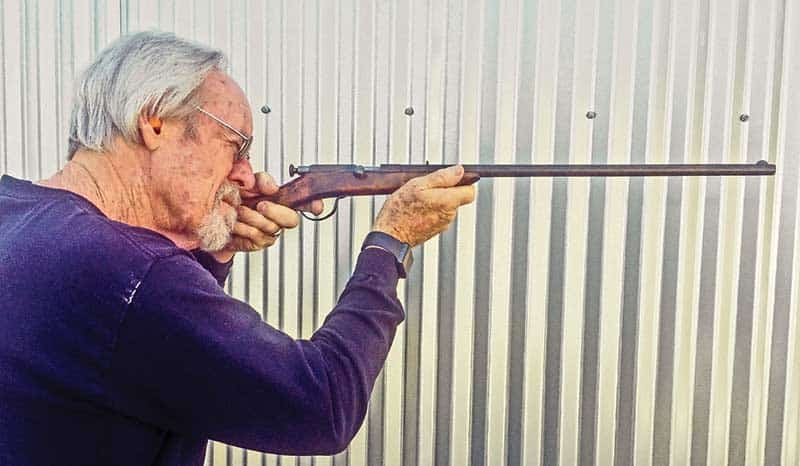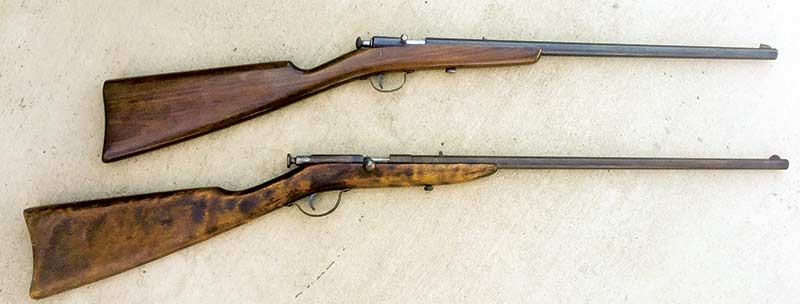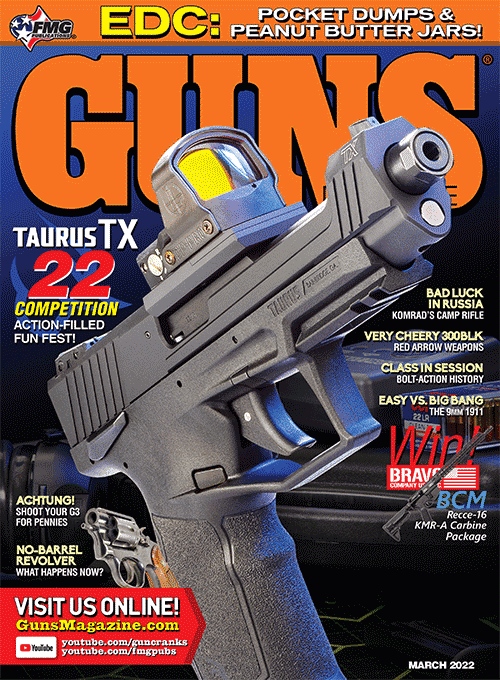Page-Lewis Model D
The essence of a single-shot “Boy’s .22”
Throughout the first half of the 20th Century, it seems virtually every American gunmaker offered at least one “boy’s rifle.” This was generally a no-frills, single-shot .22 with an extremely modest price tag and scaled-down dimensions.
Remington, Winchester, Mossberg, Marlin, Savage and Stevens had them, and in some cases still do. Later, a few companies actually specialized in such rifles — Chipmunk, Henry and Keystone are currently filling this niche admirably.
But sadly, a lot of “boy’s rifle” companies dropped by the wayside well before the Second World War. Gunmaking concerns such as Quackenbush, Hamilton and Page-Lewis are now known by a relatively small number of collector/obsessives
Passion Satisfied
Thanks to our shooting buddy John Wightman’s unquenchable fetish for vintage .22s, a Page-Lewis Model D Reliance is what we lucked into. In James J. Grant’s Boy’s Single Shot Rifles (William Morrow & Co., 1967), the author lauds the little bolt gun’s bona fides as a beginner’s tool and describes a fairly unconventional action:
“This little bolt action was a very safe and practical arm for a boy. When a cartridge was inserted into the chamber and the bolt was closed, the bolt went into a half-cock or safe position so the firing pin was not in contact with the cartridge head. Then, to fire the piece, the knurled bolt head was drawn to the rear to cock it … However, the bolt of this Page-Lewis mechanism behaves in an unorthodox manner. When the usual knurled knob is drawn to the rear to cock it, about two thirds of the bolt body follows along and when the trigger is pulled, falls. The flat firing pin is of course attached to the long rear of the bolt body and slides in a groove milled along the outside surface of the front one third of the bolt body.”
To make a long story short, both Mr. Page and Mr. Lewis were originally employed by Stevens in Chicopee Falls, Mass. and eventually sold their business to Savage — which had also acquired Stevens. Prior to that, Page-Lewis guns had been sold by Stevens under the company’s Springfield line (not to be confused with Springfield Armory).
Originally, Page-Lewis had produced simple rolling block designs before they moved to bolt actions. The Model D Reliance was designed as an entry level item and was produced from 1923 to 1928. The initial list price was $5.87, but the model was eventually replaced with the more refined Stevens M52.
Before anyone gets excited enough over the prospect of a $5.87 sticker price and starts looking for a time machine, it’s worth keeping in mind that in terms of actual buying power, the price translates today to $92.57.
The actual year of manufacture for John’s specimen, incidentally, is a bit hazy as the Model D — like many firearms of its era — was not serial-numbered.
Plain And Simple
The rifle itself is about as straightforward an item as you might expect. It has a 20″ barrel, fixed sights and a hardwood stock which we’ve been unable to positively identify in terms of wood type — our best guesses revolve around birch or gumwood.
Our range notes indicate although the fixed sights can be challenging even at 25 yards, the fixed rear sight of the Page-Lewis is a relatively large square notch. When paired with the commensurately tall front blade, the resulting arrangement is superior to the microscopic fixed sights often seen on .22s of its time period.
The sights, plus the excellent trigger pull — a darn-near nonexistent 2 lbs. —permitted some fairly tight groups with Federal 40-grain Gold Medal Match and less pricey “bulk pack” Winchester 36-grain HPs. In fact, the Winchester stuff outshot the premium Federals, which just goes to show you there is no substitute for the time-consuming grunt work of shooting as many brands and weights of rimfire ammo as possible in a new gun before settling on one.
Naturally, this goes double when you’re shooting a fixed-sight oldie and are obliged to find a workable compromise between tight groups and a reasonably agreeable Point of Aim/Point of Impact relationship.
There’s a lot to be said for a single-shot .22. Sheer simplicity is always a virtue, and if it’s a vintage model, you’ll never have to worry about finding a replacement box magazine. And in this time of ammo uncertainty, it’s nice to know you and yours are unlikely to burn through a 50-round box of Long Rifles before the next ceasefire!
RELATED ARTICLES
Purchase A PDF Download Of The GUNS Magazine March 2022 Issue Now!








